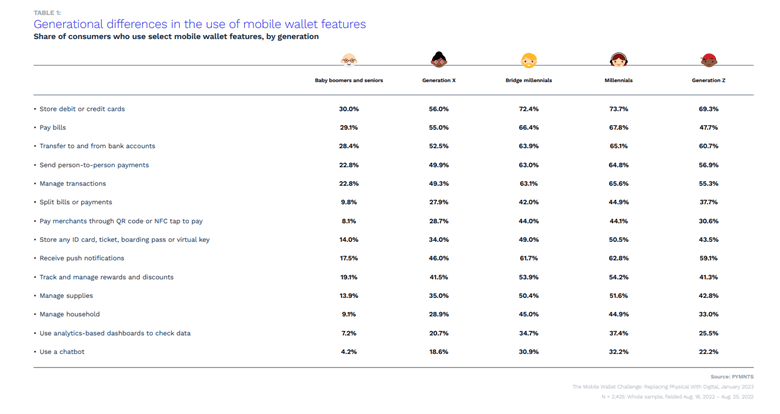
Millennials, born between 1981 and 1996, are the youngest entire generation who have fully reached adulthood. As well, they are the first of what we would consider to be “technology natives,” as they were born before the widespread advent of the internet but after the popularity of home PCs.
Perhaps due to that early exposure to nascent home technologies, millennials are the age cohort adopting digital technologies such as wallets and online pay portals most.
We analyzed five of PYMNTS’ key research themes — healthcare, finances, payment preferences, food and banking security — in order to form a top-down view of what drives this valuable demographic for marketers and merchants.
Healthcare: Millennials are most likely to use a payment plan for routine doctor bills, with 11% of those surveyed having used an alternate payment plan for their most recent provider visit. This may suggest a comfort with credit — or that their budgetary priorities lie elsewhere. Data shows that 64% of millennials used a payment plan for their most recent surprise medical bill, also making them the generation most likely to do so.
Perhaps due to the extended repayment nature of installment plans, millennials are more likely to use a digital portal than pay in person, at 40% versus 34%, respectively. Millennials are also the age cohort most preferring digital portal payments, with 28% citing the method as their favorite.
In line with this lean towards innovation, of those surveyed, millennials are the demographic most likely to pay for these bills via mobile wallet, with 51% having done so for a healthcare-related bill in Q2 2022.
Payment Preferences: When it comes to payment preferences overall, millennials show an affinity for digital wallets. Although trailing behind Gen Z among consumer demographics willing to try new methods overall, 67% of millennials have adopted digital wallets. This makes them the demographic most likely to have done so over the year previous to being surveyed.
In line with this affiliation with innovations such as digital wallets, 44% of millennials surveyed believe mobile wallets can replace most or all features of a physical wallet. As noted in the PYMNTS collaboration with ACI, “Mobile Wallet Challenge: Replacing Physical With Digital,” millennials consistently utilize the most wallet features of all age demographics, an average 8.1 per user.

An interesting anomaly bucking this generational digital trend, however, is millennial banking preferences. Of the age cohort surveyed, while 25% bank digital-only, 13% bank solely at institutions with physical locations, making them second only to baby boomers and seniors in this preference.
Finances: Nearly three-quarters of surveyed millennials live with a spouse or partner, with 70% indicating they also live with children or grandchildren. The increased financial responsibility that comes with supporting children may be the cause of some millennial financial lifestyle habits, as 44% live paycheck-to-paycheck without issues paying bills and another 39% live paycheck-to-paycheck with bill pay issues. These high shares persist despite the reality that 66% of millennials hold down full-time jobs, representing the highest rate amongst the younger generations.
When it comes to housing, 30% are rent payers, with another 32% owning a home but paying on a mortgage. Unfortunately, millennials also exhibit the highest share of giving up on the dream of homeownership, as the portion of those believing in the possibility dropped from 39% to 31% between January 2021 and January 2023.
Food: Surveyed millennials most prefer to combat inflation when eating out by purchasing from restaurants less often (23%) or seeking out restaurants with lower menu prices (19%). They are the age demographic most likely to decrease the amount of food per order when they do eat out, as 11% of respondents reporting making this change.
These cost-cutting strategies do not apply to their tipping behavior, as 96% of those surveyed left a tip at their last table-service meal and 80% doing the same for their last QSR meal.
Millennial cost-cutting extends to grocery shopping as well, with 29% of those surveyed admitted trading down in both quality and quantity to make ends meet. Another 14% reduced only the quality of their groceries.
Banking Security: Millennials demonstrate strong faith in their primary bank’s security measures, with 42% of those surveyed strongly agreeing that their financial institutions provide the highest level of security and another 43% agreeing with that same statement. Despite being the age demographic most comfortable with their bank’s mix of visible and invisible security measures, 32% would still prefer more visible security measures.
Millennials, while not exactly digital natives, are the first generation as a whole to have technology integrated into their daily lives, and their comfort shows.
Perhaps because of these early influences, they are also most likely to adopt new technologies such as mobile and digital wallets and place a fairly high amount of trust in these innovations. These integrations into their daily lives has all but secured millennials’ place in the larger ConnectedEconomy™.